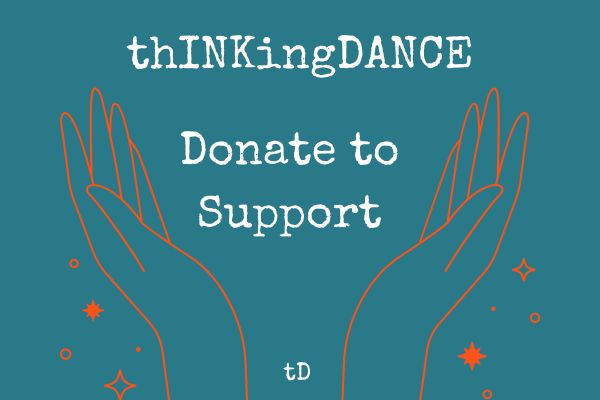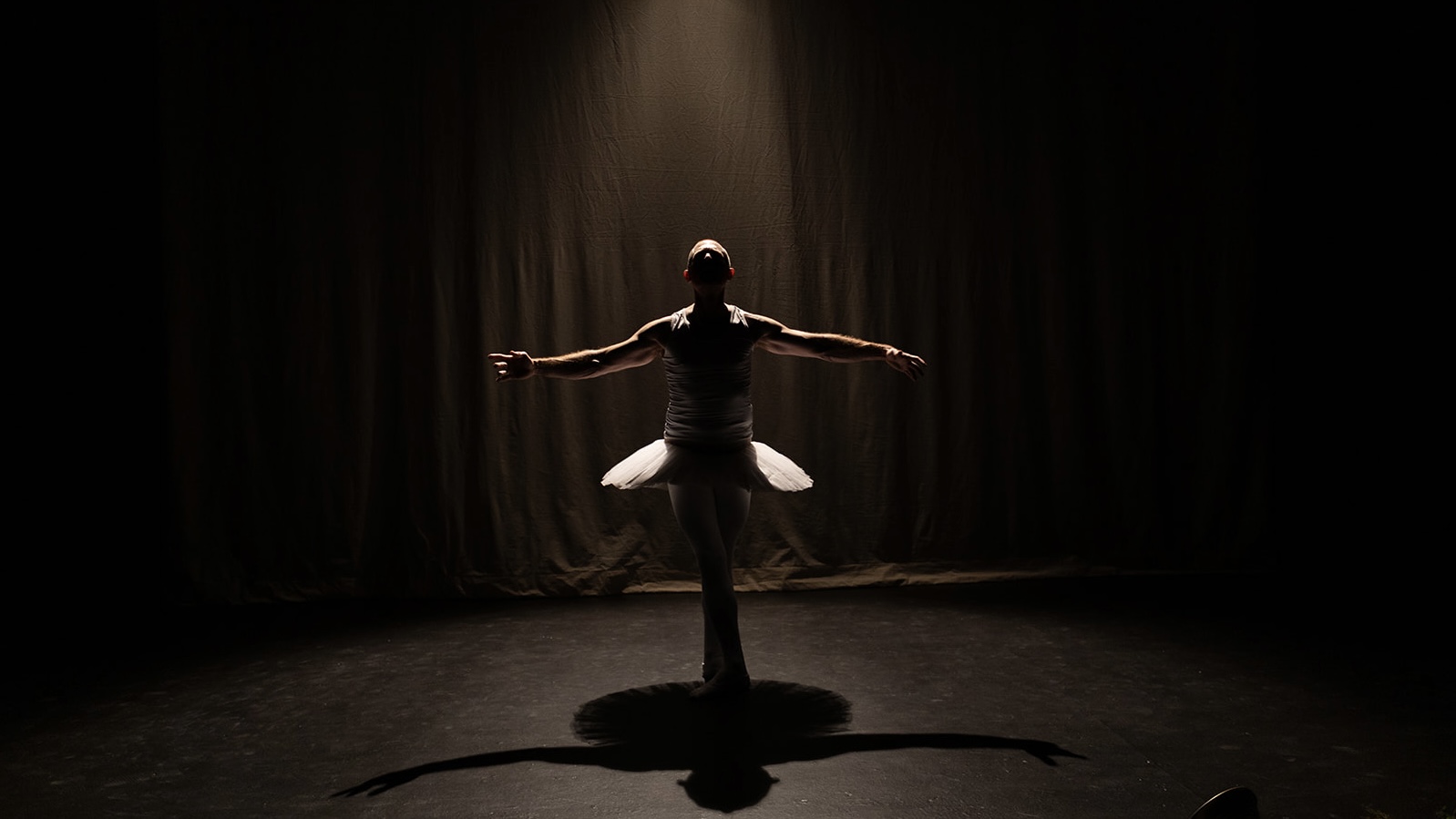A giant black cavern towers upstage of the space at the Gershman Y. Birdsong and thunder eventually give way to an ominous soundscape that supports the interior world of a lone creature, holed up on the mezzanine above us. This creature, goblin, brute is soaked in a juicy red light that highlights the many furrows of its elven face. Layers of masks peel off to reveal an at once horrifying and endearing visage that gazes longingly into a fixed point, like looking in the mirror before a night out, checking in and then looking out to us in the audience as if to ask, “Do you desire me? Would we share a kiss on the dance floor?”
The brute’s world is an intimate one, voyeuristic, yearning for a relationship with us, establishing the context of deep longing that threads through BRUTE, Mark Caserta’s latest offering through BigKid Dance. The work morphs through dense thickets of lush phrases that pulsate, throb, and scatter, clearing regularly to reveal concentrated pairings where themes of control, domination, and an insatiable hunger for connection, lensed queerly and danced bravely and earnestly by Caserta’s incredibly gifted dance artists. The group boils to a fevered roll, reducing to a concentrate when each duet begins, inviting us into ever deepening dialogues. Using languages created and destroyed by the dancers within the long/short life cycle of each pairing, each duet is a container offering distinct temperatures of experience: some haunting and gory; others circle themselves, not fully resolving; some hopeful and sparse. From the scintillating potential of the duets come solo moments, Caserta’s choreographic strong-arm. Since BigKid’s inception, Caserta’s incisive eye and keen relationship with bodily tension, storytelling, and moodscape have carved out tracts of choreography and story arcs that highlight a person or relationship to root for and moments we can feel in the backs of our throats. His solo arcs read cinematically like montage, showing a character’s life cycle in a pool of light in a pinpoint of time. I found myself silently cheering for soloists Mikey Morado and Chip Alexandria.
That same thick red light punctuates the vignettes of group/pairing into solo work, almost like a signal to end. After one of these moments, as the red collects a duet back into the cave, the temperature shifts as Morado steps into a blue pool of light, pointing to two fixed points before them as if to say, “This is where it happened, this is the site of something important to me.” The solo aches with ticks, then smoothes into slinks, then grooves into gallops, guiding us through an interior world thick with tension and nuance, danced stealthily and expertly by Morado; sinewy, reptilian, other-etherly. A rarity of clarity, Morado’s quality is like molten lava that has cooled on the surface as it rolls down a slope: hardening to a thin patina that is only but so thin, bursting open often to reveal a scorchingly hot, viscous, roiling quality underneath. Crisply queer, potently sensual, and magnetically engrossing, Morado shows their range as an experiencer of movement worlds and a clear conduit for kinetic messaging.
A loud smack abruptly shuts Morado’s environment down and they’re laid waste to the floor.
“They’re falling
I love you more than all the stars in the sky
Can you hold me?… I just wanted to be held…I just wanted to save them. I’m a saver…I’m sorry.”
From the dark, Alexandria collects Morado in her lap, a Pietà in pale blue. Opening up from the soft borders of the pool that she’s spoken these tender words from, she rises matter-of-factly and begins carving out her own world. Having shed the weight of her fallen star/love, the exquisite ecstasy of relief from burden and expectations pours out like a cool fresh spring after a long trek in the desert. While set to birdsong and a crystalline sound bath, this tract of dance is sincere and breathtaking in its exploration of ecstatic abandon. Without being hop-skippy-jumpy and rosy cheeked, Alexandria paints the space with an exhilarating, palate-cleansing love letter to a deep heart carrying all the stars in the sky. Ecstatically, tenderly, I’m rooting for this person on a journey to themselves after shouldering another, a journey where we see them shed and shed times over, breaking and then suturing the space back together. This is one of the few times in BRUTE where an artist takes up massive swathes of space in their solo moment with us, highlighting the piece’s tussles with desire; desire for freedom, touch, love, intimacy, to be held, heard.
This short-lived glimpse into what true freedom to be one’s own star-catcher could look like comes to its eyelid closure.
A churning unison eventually reveals Nelly Boozer and Alex Sanchez who embody a traditional masc/fem gender dynamic, potent with complex relationship themes that manifest in flesh: woman as prey and as object, one that resists, justifiably and fervently, the controlling factors around her but is repeatedly and violently rebuffed. Ultimately, she is consumed, to sounds of wolf snarling and gnashing of teeth to flesh, with only the legs of dancers’ semi-circling to mask the carnage. It’s an important statement in a time where we are plugged in far too often to the gores of living on a planet on fire.
BRUTE, Gershman Hall Y Gym Theater, Feb. 15-16, Streaming through Feb. 24.
Homepage Image: A masked, tattooed figure wearing a black sequined top is painted in bright red light, slowly peeling off layers of their mask.
Title image: A richly toned dancer is lit by single light gazing upward against a dark background.






